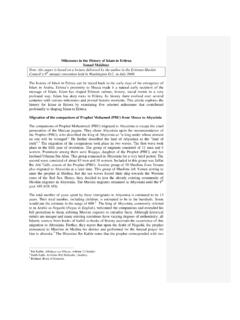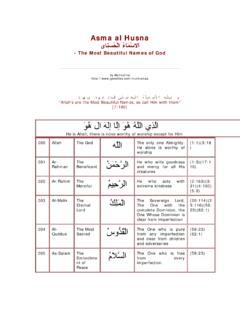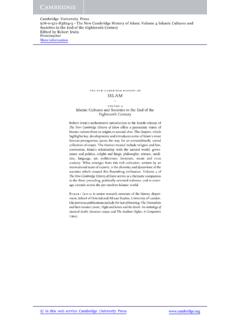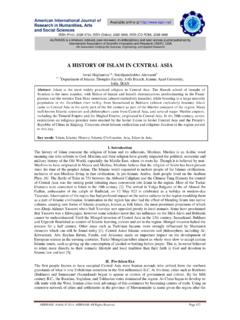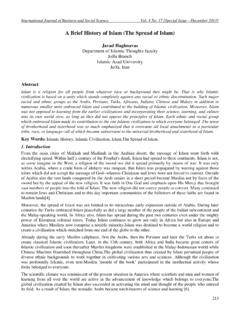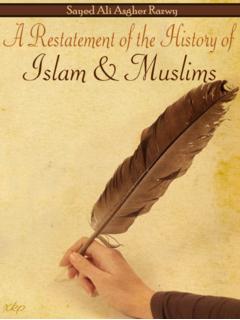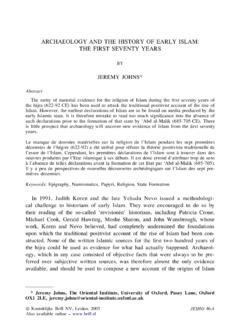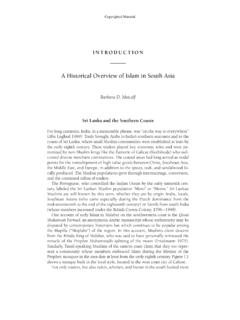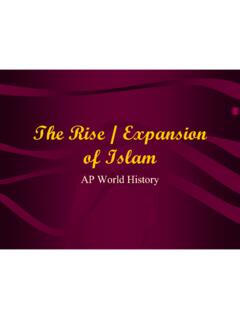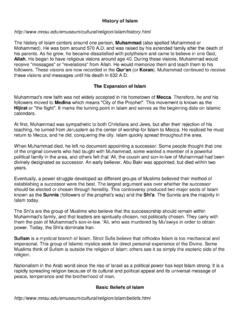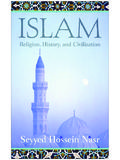Transcription of Summary of Islamic History - Muslim Population
1 Summary of Islamic History From the oasis cities of Makkah and Madinah in the Arabian desert, the message of islam went forth with electrifying speed. Within half a century of the Prophet's death, islam had spread to three continents. islam is not, as some imagine in the West, a religion of the sword nor did it spread primarily by means of war. It was only within Arabia, where a crude form of idolatry was rampant, that islam was propagated by warring against those tribes which did not accept the message of God -- whereas Christians and Jews were not forced to convert. Outside of Arabia also the vast lands conquered by the Arab armies in a short period became Muslim not by force of the sword but by the appeal of the new religion. It was faith in One God and emphasis upon His Mercy that brought vast numbers of people into the fold of islam . The new religion did not coerce people to convert.
2 Many continued to remain Jews and Christians and to this day important communities of the followers of these faiths are found in Muslim lands. Moreover, the spread of islam was not limited to its miraculous early expansion outside of Arabia. During later centuries the Turks embraced islam peacefully as did a large number of the people of the Indian subcontinent and the Malay-speaking world. In Africa also, islam has spread during the past two centuries even under the mighty power of European colonial rulers. Today islam continues to grow not only in Africa but also in Europe and America where Muslims now comprise a notable minority. A Summary of the development of the Muslim world and the different Calipahtes within it. The Rightly Guided Caliphs Umayyad Abbasids North Africa And Spain After the Mangol Invasion Ottoman Empire Persia India Malaysia And Indonesia Africa islam in the Western World Aftermath of the Colonial Period Arab India Far East Africa National States Conclusion The Rightly guided Caliphs Upon the death of the Prophet, Abu Bakr, the friend of the Prophet and the first adult male to embrace islam , became caliph.
3 Abu Bakr ruled for two years to be succeeded by 'Umar who was caliph for a decade and during whose rule islam spread extensively east and west conquering the Persian empire, Syria and Egypt. It was 'Umar who marched on foot at the end of the Muslim army into Jerusalem and ordered the protection of Christian sites. 'Umar also established the first public treasury and a sophisticated financial administration. He established many of the basic practices of Islamic government. 'Umar was succeeded by 'Uthman who ruled for some twelve years during which time the Islamic expansion continued. He is also known as the caliph who had the definitive text of the Noble Quran copied and sent to the four corners of the Islamic world. He was in turn succeeded by 'Ali who is known to this day for his eloquent sermons and letters, and also for his bravery. With his death the rule of the "rightly guided" caliphs, who hold a special place of respect in the hearts of Muslims, came to an end.
4 Umayyad The Umayyad caliphate established in 661 was to last for about a century. During this time Damascus became the capital of an Islamic world which stretched from the western borders of China to southern France. Not only did the Islamic conquests continue during this period through North Africa to Spain and France in the West and to Sind, Central Asia and Transoxiana in the East, but the basic social and legal institutions of the newly founded Islamic world were established. Abbasids The Abbasids, who succeeded the Umayyads, shifted the capital to Baghdad which soon developed into an incomparable center of learning and culture as well as the administrative and political heart of a vast world. They ruled for over 500 years but gradually their power waned and they remained only symbolic rulers bestowing legitimacy upon various sultans and princes who wielded actual military power.
5 The Abbasid caliphate was finally abolished when Hulagu, the Mongol ruler, captured Baghdad in 1258, destroying much of the city including its incomparable libraries. While the Abbasids ruled in Baghdad, a number of powerful dynasties such as the Fatimids, Ayyubids and Mamluks held power in Egypt, Syria and Palestine. The most important event in this area as far as the relation between islam and the Western world was concerned was the series of Crusades declared by the Pope and espoused by various European kings. The purpose, although political, was outwardly to recapture the Holy Land and especially Jerusalem for Christianity. Although there was at the beginning some success and local European rule was set up in parts of Syria and Palestine, Muslims finally prevailed and in 1187 Saladin, the great Muslim leader, recaptured Jerusalem and defeated the Crusaders. North Africa And Spain When the Abbasids captured Damascus, one of the Umayyad princes escaped and made the long journey from there to Spain to found Umayyad rule there, thus beginning the golden age of islam in Spain.
6 Cordoba was established as the capital and soon became Europe's greatest city not only in Population but from the point of view of its cultural and intellectual life. The Umayyads ruled over two centuries until they weakened and were replaced by local rulers. Meanwhile in North Africa, various local dynasties held sway until two powerful Berber dynasties succeeded in uniting much of North Africa and also Spain in the 12th and 13th centuries. After them this area was ruled once again by local dynasties such as the Sharifids of Morocco who still rule in that country. As for Spain itself, Muslim power continued to wane until the last Muslim dynasty was defeated in Granada in 1492 thus bringing nearly eight hundred years of Muslim rule in Spain to an end. After the Mangol Invasion The Mongols devastated the eastern lands of islam and ruled from the Sinai Desert to India for a century.
7 But they soon converted to islam and became known as the Il-Khanids. They were in turn succeeded by Timur and his descendents who made Samarqand their capital and ruled from 1369 to 1500. The sudden rise of Timur delayed the formation and expansion of the Ottoman empire but soon the Ottomans became the dominant power in the Islamic world. Ottoman Empire From humble origins the Turks rose to dominate over the whole of Anatolia and even parts of Europe. In 1453 Mehmet the Conqueror captured Constantinople and put an end to the Byzantine empire. The Ottomans conquered much of eastem Europe and nearly the whole of the Arab world, only Morocco and Mauritania in the West and Yemen, Hadramaut and parts of the Arabian peninsula remaining beyond their control. They reached their zenith of power with Suleyman the Magnificent whose armies reached Hungary and Austria. From the 17th century onward with the rise of Westem European powers and later Russia, the power of the Ottomans began to wane.
8 But they nevertheless remained a force to be reckoned with until the First World War when they were defeated by the Westem nations. Soon thereafter Kamal Ataturk gained power in Turkey and abolished the six centuries of rule of the Ottomans in 1924. Persia While the Ottomans were concerned mostly with the westem front of their empire, to the east in Persia a new dynasty called the Safavids came to power in 1502. The Safavids established a powerful state of their own which flourished for over two centuries and became known for the flowering of the arts. Their capital, Isfahan, became one of the most beautiful cities with its blue tiled mosques and exquisite houses. The Afghan invasion of 1736 put an end to Safavid rule and prepared the independence of Afghanistan which occured fommally in the 19th century. Persia itself fell into tummoil until Nader Shah, the last Oriental conqueror, reunited the country and even conquered India.
9 But the rule of the dynasty established by him was short-lived. The Zand dynasty soon took over to be overthrown by the Qajars in 1779 who made Tehran their capital and ruled until 1921 when they were in turn replaced by the Pahlavis. India As for India, islam entered into the land east of the Indus River peacefully. Gradually Muslims gained political power beginning in the early 13th century. But this period which marked the expansion of both islam and Islamic culture came to an end with the conquest of much of India in 1526 by Babur, one of the Timurid princes. He established the powerful Mogul empire which produced such famous rulers as Akbar, Jahangir, and Shah Jahan and which lasted, despite the gradual rise of British power in India, until 1857 when it was officially abolished. Malaysia And Indonesia Farther east in the Malay world, islam began to spread in the 12th century in northem Sumatra and soon Muslim kingdoms were establishd in Java, Sumatra and mainland Malaysia.
10 Despite the colonization of the Malay world, islam spread in that area covering present day Indonesia, Malaysia, the southern Phililppines and southern Thailand, and is still continuing in islands farther east. Africa As far as Africa is concerned, islam entered into East Africa at the very beginning of the Islamic period but remained confined to the coast for some time, only the Sudan and Somaliland becoming gradually both Arabized and Islamized. West Africa felt the presence of islam through North African traders who travelled with their camel caravans south of the Sahara. By the 14th century there were already Muslim sultanates in such areas as Mali, and Timbuctu in West Africa and Harar in East Africa had become seats of Islamic leaming. Gradually islam penetrated both inland and southward. There also appeared major charismatic figures who inspired intense resistance against European domination.
